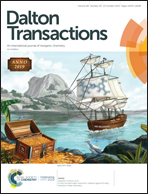Symmetry breaking structural phase transitions, dielectric properties and molecular motions of formamidinium cations in 1D and 2D hybrid compounds: (NH2CHNH2)3[Bi2Cl9] and (NH2CHNH2)3[Bi2Br9]†
Abstract
Two organic–inorganic hybrid halobismuthates(III), (NH2CHNH2)3[Bi2Cl9] (FBC) and (NH2CHNH2)3[Bi2Br9] (FBB), have been prepared with their structures revealed by single-crystal X-ray diffraction at various temperatures. FBC is characterized by one-dimensional (1D) [Bi2Cl9]3−∞ anionic chains built by edge-sharing BiCl6 octahedra, whereas FBB adopts a layer structure (2D) [Bi2Br9]3−∞. Both materials were found to exhibit a rich polymorphism in the solid state. FBC undergoes two reversible phase transitions (PTs) at 218/220 K and at 123/126 K (cooling/heating), respectively, whereas for FBB also two PTs occur close together at 196/199 K and at 190/188 K. Dielectric response around the PT temperatures of FBC and FBB reflects high disorder of dipolar groups over the high temperature phases. The ‘order–disorder’ mechanism of these PTs is assigned to the dynamics of formamidinium cations. FBB is considered as a ferroic material exhibiting ferroelastic domains below 196 K. The molecular motions of organic cations in a wide temperature range were studied by means of 1H NMR (spin–lattice relaxation time). Presented findings will provide a new method to explore organic−inorganic multifunctional PT materials.
![Graphical abstract: Symmetry breaking structural phase transitions, dielectric properties and molecular motions of formamidinium cations in 1D and 2D hybrid compounds: (NH2CHNH2)3[Bi2Cl9] and (NH2CHNH2)3[Bi2Br9]](/en/Image/Get?imageInfo.ImageType=GA&imageInfo.ImageIdentifier.ManuscriptID=C9DT02916H&imageInfo.ImageIdentifier.Year=2019)


 Please wait while we load your content...
Please wait while we load your content...